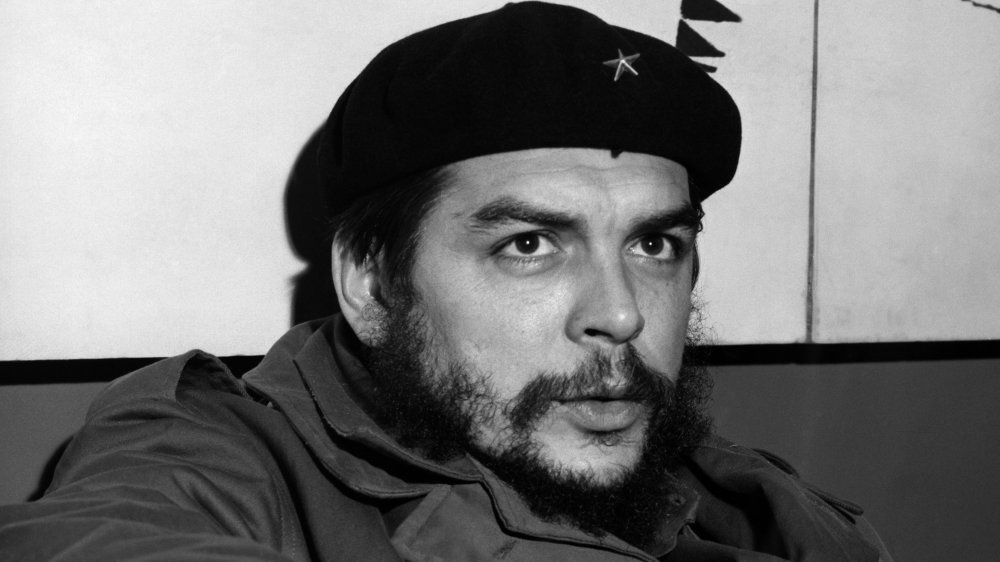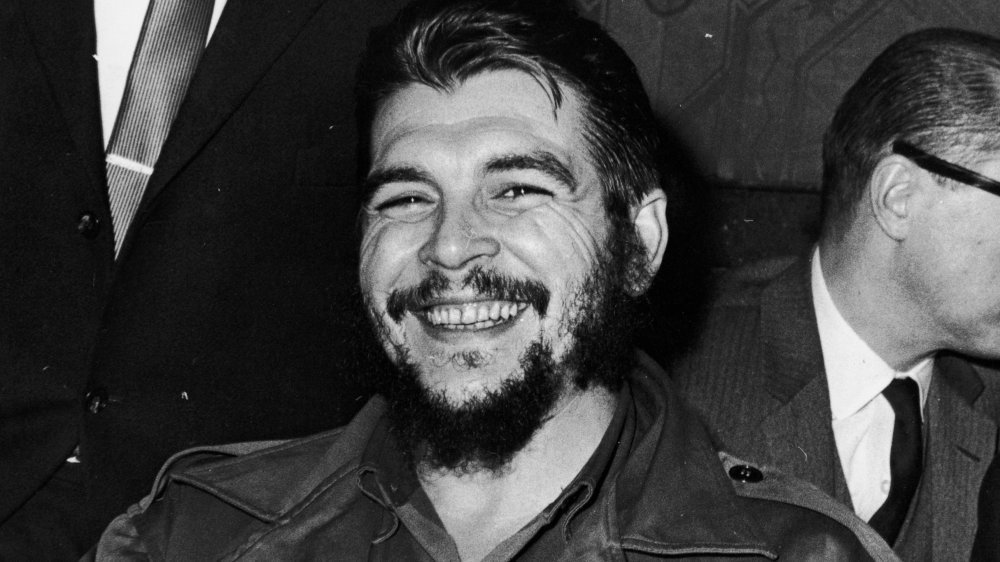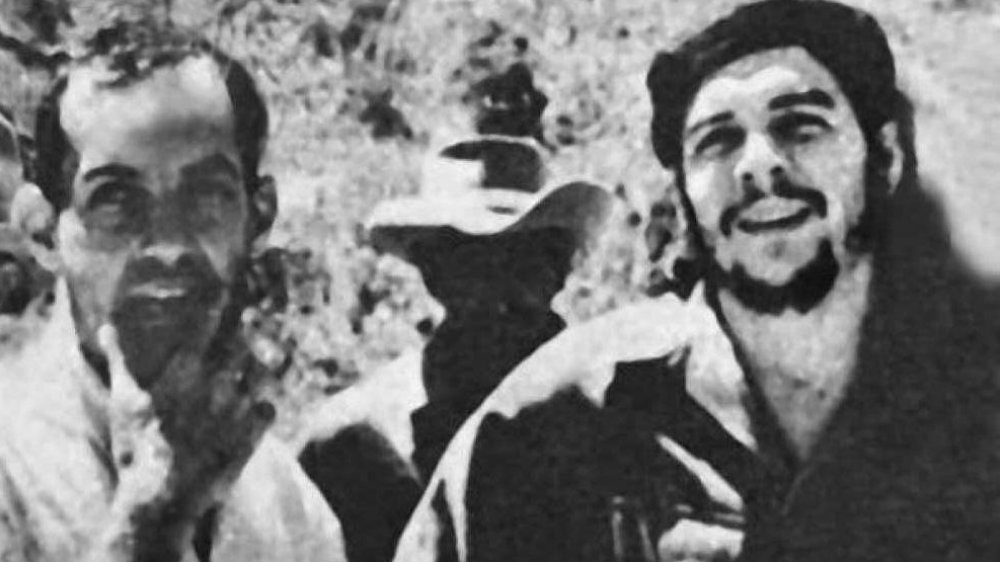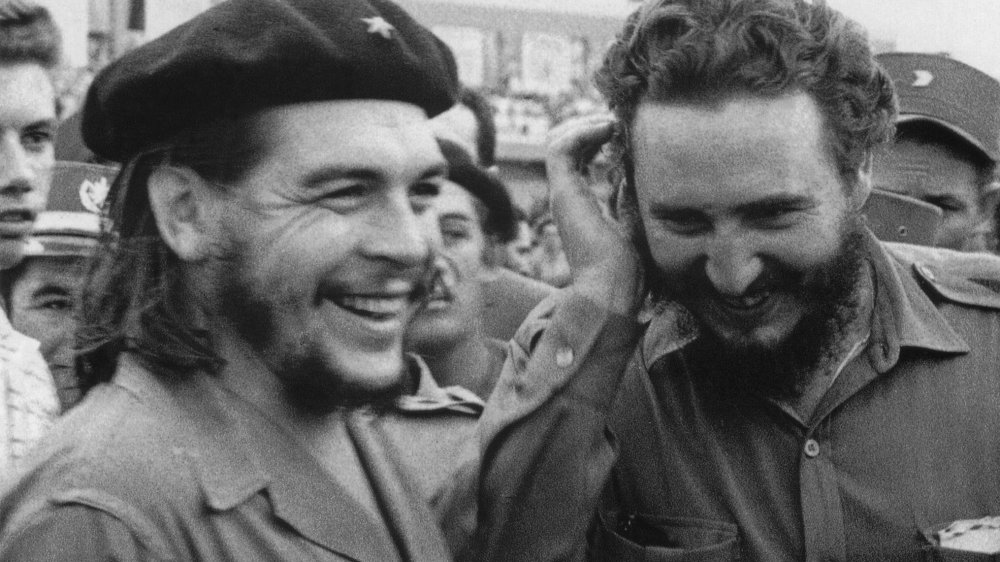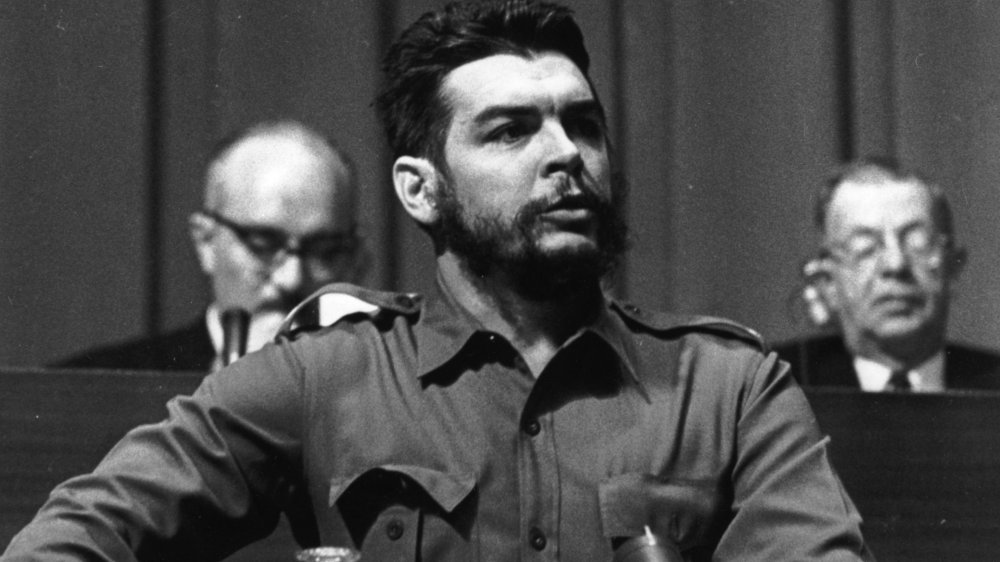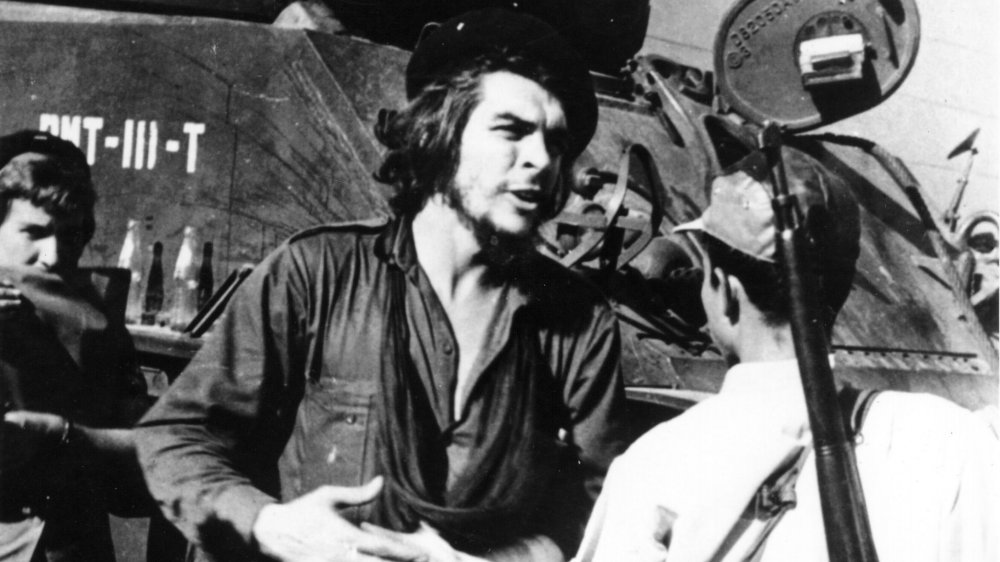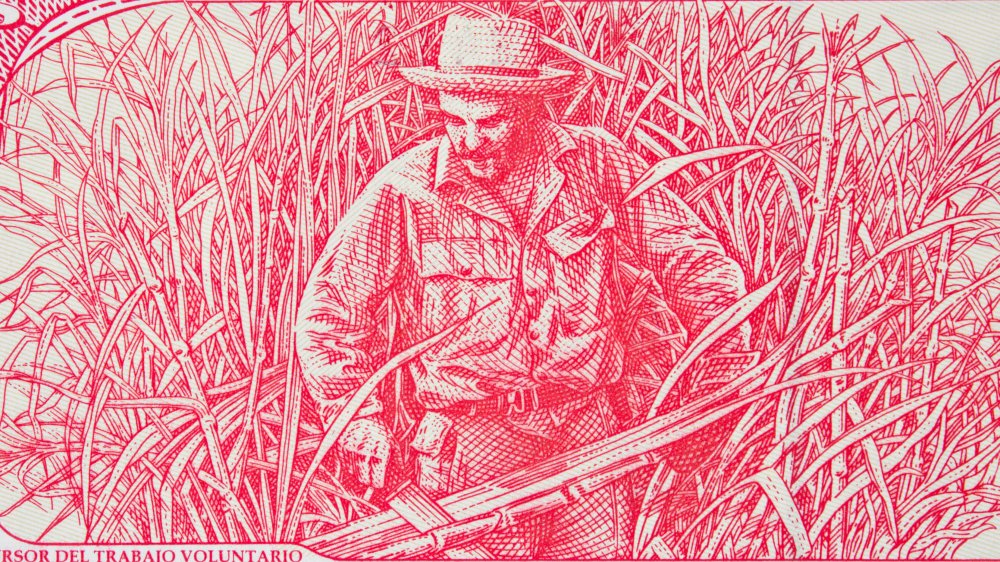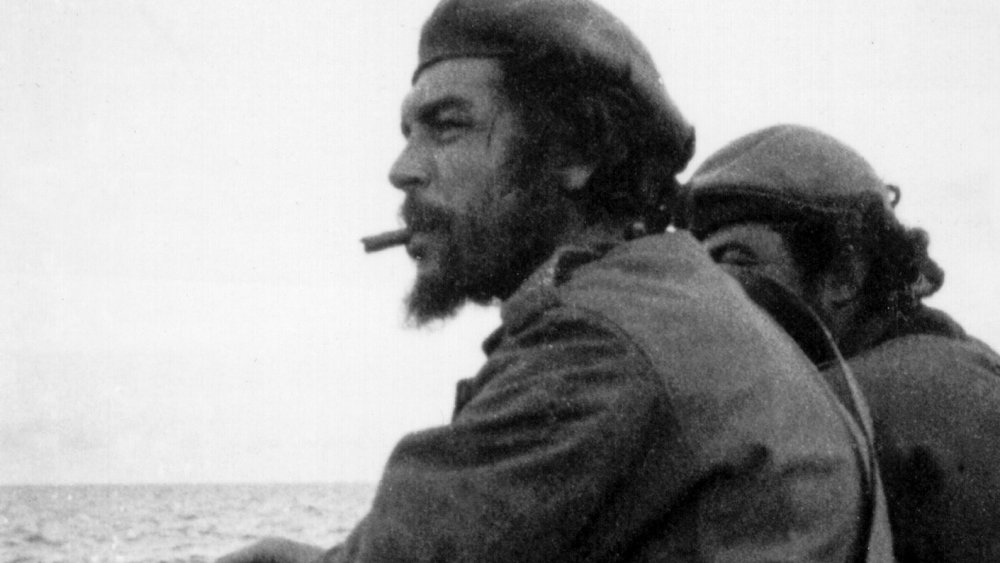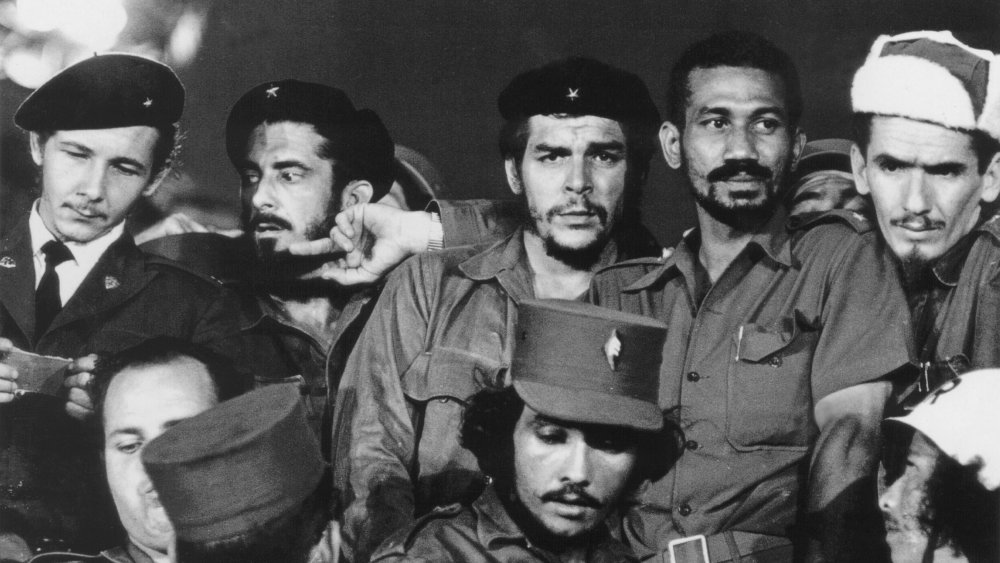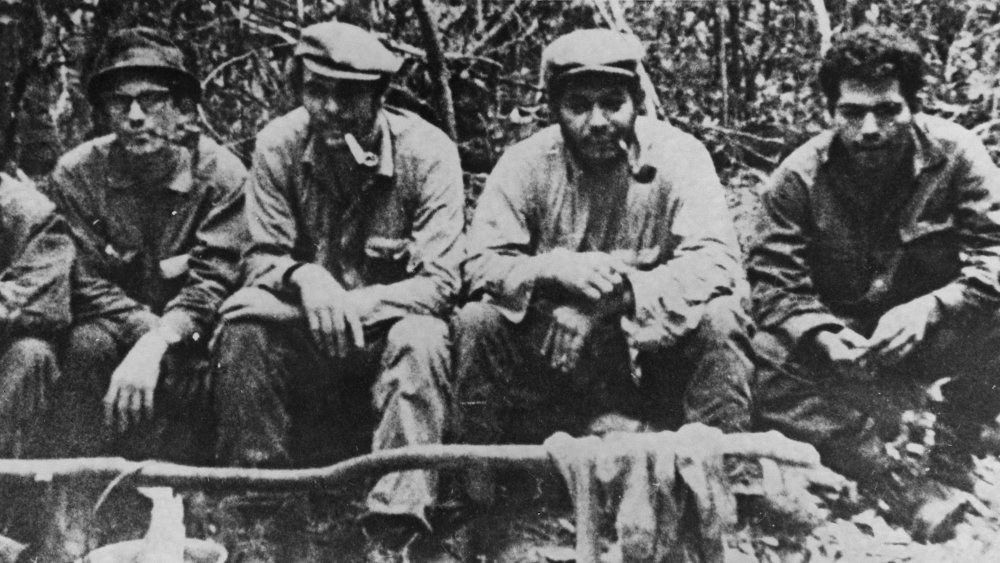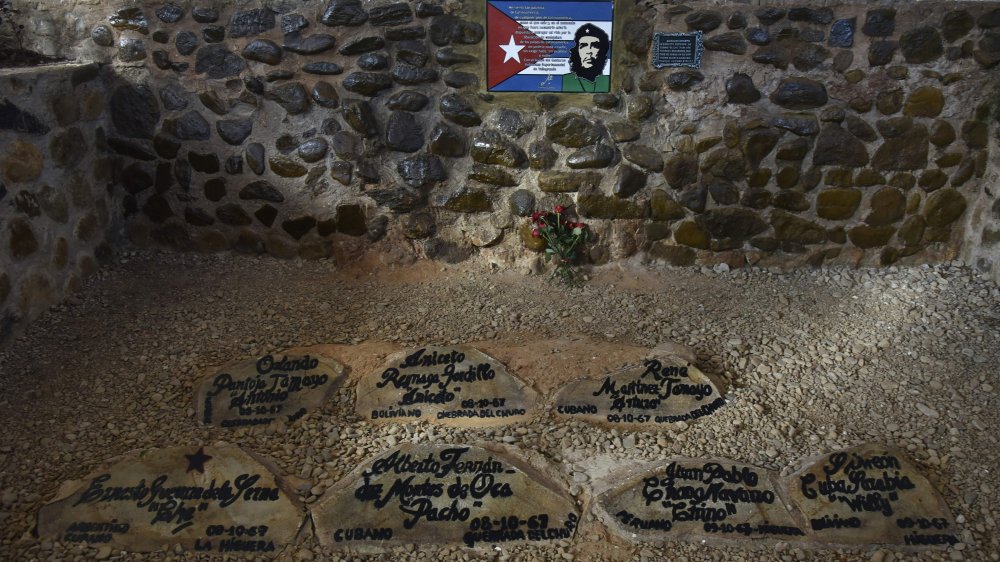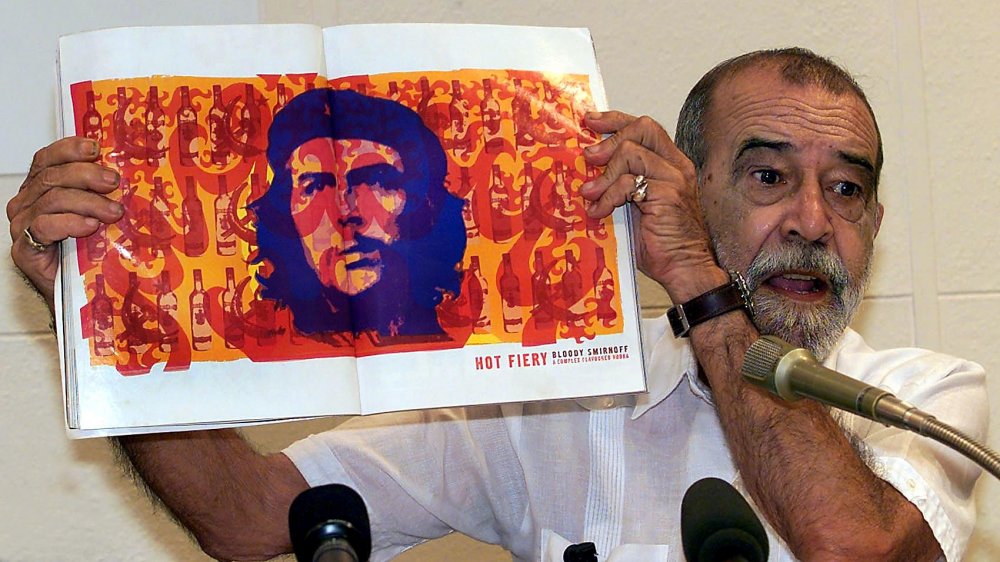The Tragic Real-Life Story Of Che Guevara
Ernesto "Che" Guevara is every hipster's favorite revolutionary. You can find him looking heroic on millions of dollars' worth of T-shirts and posters around the world. He was a radical leftist icon essentially from the time of his death, inspiring the "rebel" within us all. But most of what people know about Che Guevara is the life of the legend, not the life of the man. Guevara's life was one of struggle, his ideals defeated over and over, his death gruesome, and his burial disrespectful. He faced failure at nearly every turn.
Guevara went from a well-to-do Argentinian citizen to a communist leader with a brilliant tactical mind for guerrilla warfare and then went on to become the image of rebellion in movies and on merchandise. He was also a writer who recorded his journeys and tactical methods, many of which would later be published, turned into movies, and used to instruct armies. They'd also give us insight into the tragedy that was Che Guevara's life.
Che Guevara was plagued by asthma since childhood
Che Guevara was a militant revolutionary who took an active role both fighting on the front lines and working in the fields, a pretty insane task when you consider that he spent so much time gasping for air due to a serious case of asthma that afflicted the communist hero since childhood. These days, asthma is fairly manageable, but it was much more terrifying before the understanding and treatments that came out of the 1980s.
Preterm birth has been linked to a 50% higher risk for asthma, and according to Time magazine, Guevara was born premature and grew up as a sickly child subjected to all sorts of weird parenting methods that probably added to the severity of his disease. These included being set out on a balcony to weather winter temperatures and taking cold baths. Now, this information was pulled from another Time article from during the Cold War, so it's hard to tell what information was playing into the political agenda at the time. He was a communist after all.
What we can confirm from multiple sources, such as PBS, is that asthma played a major role in the rebel's life. Some believed it helped form his indomitable will and mental fortitude, since Guevara was forced to battle the respiratory disease in order to survive, let alone fight in multiple rebellions around the globe.
Che Guevara's worldview was shattered
There have been a few revolutionary leaders in the past who came from comfortable wealth and gave it up to fight for a cause, but no one leaves a comfortable life without a catalyst. Many were forced into the situation, while others, like Che Guevara, had their comfortable worldview absolutely shattered.
Guevara wasn't born with an AK-47 in his hands and a cause to charge after. He was born to a well-off, aristocratic family and was destined to become a doctor. According to Biography, a young Guevara studied medicine at the University of Buenos Aires. While taking a break from medical school, Guevara traveled South America for nine months before returning to finish his degree. His time on the road would be recorded in journals that would eventually become The Motorcycle Diaries. It would also shake up his worldview and open his eyes to the mass poverty which filled that part of the world.
From medical school, Guevara would travel once again, this time to a progressively controlled Guatemala that would be overthrown in a CIA coup the following year, according to Britannica. That overthrow was the final straw for the future communist hero. From then on, Guevara would be convinced of two things: The US would always fight against progressive governments, and the only way to change this would be a socialist revolution across the globe.
Che Guevara witnessed slaughter in his first militant move next to Castro
During Guevara's travels after medical school, he would hop from Guatemala to Mexico and meet two brothers who had revolutionary ideas of their own: Raúl and Fidel Castro. And with this fateful meeting came Guevara's descent down the revolutionary rabbit hole. At the time, according to Britannica, the Castro brothers were exiles from Cuba who were set on returning to their home country and overthrowing the then-current regime. Che Guevara was a young man with a yearning to join a cause similar to what the Castros were trying to achieve, so the math added up.
Guevara joined the two brothers in their 26th of July Movement, the insurgent movement into Cuba, which kicked off for Guevara when he and roughly 80 men landed on the shores of the island nation after several days of traveling on a small yacht. To the company's surprise, the Cuban forces had caught wind of the invasion. A patrol boat spotted the insurgents and opened fire. According to History Today, all of the invaders made it out alive but were ambushed three days later. The majority were either killed, captured, or driven to give up on insurgency all together. Those who remained true to the cause would eventually regroup in the Sierra Maestra mountains. It just goes to show: If at first you don't succeed, you were probably ambushed, at least if you're Che Guevara.
Che Guevara wasn't good at his job in Cuba
Che Guevara was many things, but he definitely wasn't an economist, which was the exact position he found himself in after Fidel Castro took power in Cuba. Castro fired the former president of the national bank and gave the title to Guevara. According to CNBC, Castro admitted, after the fact, that it was a regrettable decision, saying he put him there out of trust and not because he was a good man for the job.
A common joke about Guevara from the '60s states that Castro, while deciding who would run the national bank, asked who among his lieutenants was an economist. Guevara raised his hand. When informed of his new position, he admitted to mishearing Castro, thinking his leader had asked, "Who here is a communist?" The joke stems from Guevara's lack of financial knowledge, which is believed to have aided Cuba's descent into economic hardship. Granted, the trade sanctions put on them during the Cold War certainly had something to do with it as well.
One of Guevara's biggest blunders was the armed seizure of American banks on Cuban land that eventually left the country owing roughly $5 billion to said banks' parent companies. The debt has been bought and sold, currently residing in the hands of a London financial group who are waiting to cash in when Cuba repays the balance.
Che Guevara was once in charge of torture and executions
Before Che Guevara found himself in charge of Cuba's national bank or acting as its minister of industries, he was in charge of torturing and executing enemies of Castro's regime. According to CNBC, he had so many political prisoners executed that he earned the name "the Butcher of La Cabaña." La Cabaña was the prison Guevara was in charge of, in which at least 144 prisoners were thought to have been executed under his orders, according to History.
Guevara's passion for the impoverished had instilled in him a deep hatred for anything and everything capitalist. He had a tendency to preach violence and hatred as the main weapons for revolution. Regardless of where a person may land on the political spectrum, no one can argue that Guevara wasn't a violent man. He was undoubtedly, for all the good or bad he may have done, a killer. This side of the rebel icon tends to be lost in a history that his popular legacy fails to acknowledge but is important to remember nonetheless if we want a full portrait of the man.
According to an interview conducted with Jon Lee Anderson, author of Che Guevara: A Revolutionary Life, by PBS, the prisoners executed under Guevara's command were killed for crimes typical of capital punishment, such as treason or murder. Unfortunately, killing is a piece of war that probably won't disappear anytime soon.
Che Guevara's crisis of faith in Cuba
There isn't enough time for an entire political theory class in this article, but to understand Guevara's crisis of faith in Cuba, you'll first have to understand that Leninism, though a branch of communism, isn't the exact same thing as Marxism. With it so far? Good. Guevara was a Marxist in a country that was increasingly moving into a Soviet Leninist brand of communism, which he wasn't a big fan of. As the alliance between Cuba and the USSR solidified, Guevara began to become disheartened. Then, the Soviets pulled a cheap move by removing their missiles from Cuban soil during the 1962 Missile Crisis without conferring with Cuban leaders.
Guevara was livid with the USSR. He became known for attacking them and their commitment to a worldwide revolution at every turn, according to PBS. He also believed that the Soviet Union was furthering colonial exploitation by trying to pressure Cuba into continuing sugarcane production. Yet Cuba continued to rely on the USSR more and more, and Guevara finally became fed up enough with the direction of the country and left in an attempt to accomplish what he'd set out to do in the first place: bring about a worldwide socialist revolution. To do that, he'd have to go quite a distance away.
Che Guevara disappears to fight a failed revolution in the Congo
There was a lot of speculation on where Che Guevara might have gone when he disappeared from the public eye in 1965. Later, the world would discover that he had traveled to the Congo, hungry to bring about a revolution in another part of the world. Since one was already underway in the region, it was a good place to start.
According to The New York Times, when Guevara showed up, Congolese rebels were already fighting a government backed by the United States — making their revolution all the more enticing. Guevara hated US imperialism, or "Yankee imperialism" as he called it, at its core. Guevara's job in all of this was to take a small group of Cuban soldiers and train the rebels in the Congo in the same guerrilla tactics that had successfully overthrown the previous Cuban government.
Unfortunately for Guevara's revolutionary track record, they ran into a slew of problems. For starters, many of the local rebels found day-to-day duties, like carrying loads, beneath them as soldiers. Some relied on the magic of potions to produce victory and would fire their weapons wildly and blindly or drop them to move faster during retreats. Following a near-disintegration of rebel forces, Guevara evacuated his men, convinced they couldn't liberate "a country that does not want to fight," according to The Guardian. This was Guevara's first failed revolution.
Che Guevara was unable to spark a revolution in his homeland
Argentina was Che Guevara's homeland. He was born there. He grew up there. And, he desperately believed it deserved a people's revolution, according to PBS. Guevara could have been content with the successful invasion of Cuba and left Argentina be. To be honest, he probably should have. Instead, Guevara enlisted the help of Jorge Ricardo Masetti, a journalist whom Guevara knew from previous interviews, in an attempt to build a communist front in northern Argentina, according to The Guardian. Previously, Guevara had failed to rile the country's communist factions into a united force. They either refused to work with each other or were straight-up scared of the violence and warfare Guevara was promising.
The Argentinian front was having issues. Guevara wasn't present himself because of his duties as minister of industry back in Cuba. Morale among the troops was low, which never helps, but what helps even less is an authoritarian leader, a role Masetti had taken up. As morale worsened, Masetti became known for executing the weakest among his own troops. Luckily, he didn't live too long into the operation. The fighters in Argentina would continue to try to get a foothold, but they'd make no real ground and eventually fizzle out after their new commander, Ciro Bustos, joined Guevara in Bolivia. It was a second failed revolution for Guevara.
Che Guevara was chased and executed by the Bolivian army
The third and final failed revolution for Che Guevara would happen in Bolivia, where Guevara and 120 other soldiers would attempt to build a front in the Santa Cruz region of the country. The operation began optimistically with some minor success for the rebels coming out of the gate, but everything would soon go wrong, according to Britannica. The US, having classified Guevara as an enemy for a while, had discovered he was in Bolivia. Within a year, according to PBS, the revolutionaries would find themselves constantly on the run from US-backed, CIA-trained uber-fighting machines ("Bolivian Rangers" for short). Great, what else could go wrong? Plenty.
The Bolivian locals turned their backs on Guevara's men. Then, the Bolivian communist party left them hanging out to dry when they backed out of their previous commitment to aid the group. Cue asthma and dysentery. Everything about the Bolivian operation had turned bleak. The final nail in the coffin may have come when a captured guerrilla drew the faces of several rebels for the Bolivian army, though, according to an interview with The Guardian, the soldier believed the rebels were as good as dead, anyway. Shortly after the sketches were produced, the Bolivian Rangers caught Guevara, shot him dead, and cut off his hands to use his fingerprints for identification.
Che Guevara's body was hidden in a mass grave for years
With his hands removed and sent back to Argentina to be identified, Che Guevara's body disappeared. Only the small group of people who buried him knew where his body was, and all three of them kept their mouths shut about it for 28 years. That is until a retired Bolivian general spilled the beans to The New York Times in 1995.
General Mario Vargas Salinas was part of the force that countered Guevara's troops, and he was present at Guevara's burial. According to Salinas, Guevara was buried in a mass grave beneath an airstrip in Vallegrande. Apparently, the point of the secret burial was an attempt to get rid of any evidence they could about the attempted insurgency in Bolivia.
Cuba, given Guevara's role in their country, wanted his body to be returned and buried on Cuban soil, but Bolivia ignored them, claiming they didn't know the location of Guevara's corpse. To be fair, most of the country didn't. He was buried with tractors alongside six other rebels in the middle of the night, and they were covered up by morning. Since the general came forward, Cuba has recovered Guevara's remains. He was given a funeral with full military honors in 1997 and currently lies in a mausoleum in Santa Clara, Cuba.
Che Guevara's legacy has ironically been cemented in consumerism
To a revolutionary communist like Che Guevara, having your legacy bastardized into a hit selling image within capitalist consumerism has to be the lowest point of tragedy. After all, it goes against everything his Marxist political philosophy stood for. Pretty much since the time of his martyrdom, his face has been printed onto T-shirts, posters, and stickers so that companies could profit. He's been used in books and movies that contributed to big bucks in the hands of Hollywood producers and major publishers. His likeness was even used in a Smirnoff vodka ad.
The most iconic of the Che Guevara images depicts the rebel sternly staring off in what looks like powerful, deep thought. This image was taken by Alberto Diaz Gutierrez. Gutierrez let the copyright for the image kind of hang in the wind, since he was happy that it was inspiring socialist revolutionaries around the world, but he decided it was time to put his foot down and claim his rights after the Smirnoff vodka fiasco. It was 40 years after the photo was taken before the rights were legally recognized in 2000 by the High Court of London, according to The Independent. Afterward, proceeds from the image rights were to go to providing children in Cuba with medicine, something that might take the edge off this tragedy for Che Guevara.
